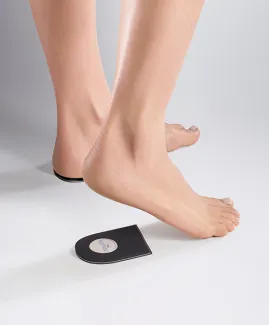
Conservative and surgical heel spur treatments are subject to a lot of questions and misconceptions. Sometimes benign, sometimes painful, this bone spur can go unnoticed or require meticulous care. However, other causes of heel pain can complicate the diagnosis and the choice of the right treatment. EPITACT® dispels the most popular misconceptions about the treatment for heel spurs.
The first heel spur treatment option consists in removing the spur.
Contrary to what one might think, heel spurs are usually painless and they are often there without us even knowing it. However, thinking that the only way of treating a bone spur on the heel is to remove it is logical. But everything is not that simple: pain can also come from another foot condition called plantar fasciitis!
This second condition corresponds to the inflammation of the plantar fascia. Both conditions are the consequence of excessive overuse of the plantar fascia (tissue that covers the plantar surface from the heel to the base of the toes). Even if the pointy shape of heel spurs seems hurtful, plantar fasciitis is often the cause of heel pain.
This inflammation leads to the formation of a heel spur where the fascia attaches to the base of the calcaneus (heel bone). Therefore, in the presence of heel spurs, some people can suffer intense heel pain. The treatment for a heel spur and plantar fasciitis are similar and removing the heel spur is rarely considered.
Insoles are not effective enough for the treatment of heel spurs.
On the contrary, using insoles or heel lifts is part of the first line heel spur treatments! At first, stop wearing shoes with hard soles which are far from being helpful in case of heel spurs.
It is recommended to put soles or heel lifts in your shoes to cushion the impact of the foot with the ground and reduce the stress in the heel. The effectiveness of the heel lifts by EPITACT®* is based on the combination of two materials: the PHYSIO'CHOC™ and the EPITHELIUM™ gel. The first one, excellent shock absorber, slightly lifts the heel while the second one reduces pressure on the painful area. Therefore, they relieve your heels and also limit joint and back pain.
The treatment of heel spurs is totally different from the treatment for plantar fasciitis.
As heel spurs and plantar fasciitis have closely related causes and symptoms, their treatment is also similar. To relieve a heel spur, the treatment consists in reducing the inflammation of the plantar fascia.
The first recommendations are simple and quick to implement. Losing weight, resting, taking anti-inflammatory drugs and wearing insoles or heel lifts* help to relieve heel pain. If all these heel spur treatments options are insufficient, other ways to relieve pain exist: discover which ones in our article about the treatments of plantar fasciitis.
Shock wave therapy is not effective at treating a bone spur on the heel.
You’ve heard about shock wave therapy for the treatment of heel spurs? Indeed, many studies have shown the benefits of this well-known approach in the management of a calcaneal spur.
The main objectives of shock wave therapy is to stimulate a healing response, microvascularisation and locally kill pain(1).
There are no natural heel spur treatments.
Without going so far as to talk about natural treatment, the first heel spur treatments are neither chemical nor invasive. Indeed, the management of calcaneal spurs begins with fighting against risk factors. Regular physical activity, comfortable shoes and rest periods to limit stress on the bottom of the foot are recommended. Let’s also note that applying cold on the painful area can reduce inflammation and soothe pain.
As a complement, insoles and heel lifts are frequently prescribed in the treatment of a heel spur. They limit stress on the plantar fascia by raising the heel of a few millimetres. The heel lifts* developed by EPITACT® act on the inflammation and provide comfort while you walk. Indeed, their heart of silicone gel reduces painful pressures at the base of the heel while the other part absorbs shock waves.
Heel spurs can’t be operated.
You wonder if you should have surgery for your heel spur? You’re probably not alone. Usually, heel pain disappears thanks to the medical treatments. Surgery is rare and only considered if the previous heel spur treatments hadn’t worked. It can also be performed if pain is too persistent or too intense.
You now know the truth about the most common misconceptions about plantar fasciitis and heel spur treatments recommendations. You want to learn more about both foot conditions? EPITACT® suggests you other articles about their symptoms and exercises for plantar fasciitis →
*This solution is a class I medical device that bears the CE marking under this regulation. Carefully read the instructions before use. Manufacturer: Millet Innovation. 08/2023
For more details about this general and simplified approach, here is another source:
(1)Saxena A, Fournier M, Gerdesmeyer L, Gollwitzer H. Comparison between extracorporeal shockwave therapy, placebo ESWT and endoscopic plantar fasciotomy for the treatment of chronic plantar heel pain in the athlete. Muscles Ligaments Tendons J. 21 janv 2013;2(4):312‑6.
 Pharmacie
Pharmacie